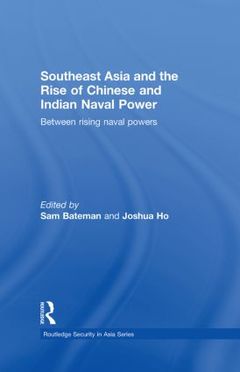Description
Southeast Asia and the Rise of Chinese and Indian Naval Power
Between Rising Naval Powers
Routledge Security in Asia Pacific Series
Coordinators: Bateman Sam, Ho Joshua
Language: English
Subjects for Southeast Asia and the Rise of Chinese and Indian Naval...:
Keywords
maritime; security; china; sea; rising; powers; navy; regional; proliferation; initiative; PLA Navy; SUA; ASW; Maritime Security; Naval Forces; Energy Resources; Regional Maritime Security; Malacca Strait; Exclusive Economic Zones; Ion; East Timor; Southeast Asian Waters; Indian Navy; East Asian Seas; China's Naval Strategy; Los Convention; Over-the Horizon Radar; Japan's Maritime Self-Defence Force; Indian Coast Guard; User States; JCG; SUA Convention; Navigation Fund; Maritime Cooperation; Asia Pacific Maritime
Publication date: 04-2010
Support: Print on demand
Publication date: 10-2012
Support: Print on demand
Description
/li>Contents
/li>Readership
/li>Biography
/li>
This book examines the emerging maritime security scene in Southeast Asia. It considers highly topical implications for the region of possible strategic competition between China and India - the rising naval powers of Asia - with a possible naval "arms race" emerging between these countries both with naval force development and operations. As part of its "Look East" policy, India has deployed naval units to the Pacific Ocean for port visits and exercises both with East Asian navies and the US Navy, but India is also concerned about the possibility of the Chinese Navy operating in the Indian Ocean. Even as the US-India defence relationship continues to deepen, the US and China are struggling to build a closer links. China?s and India?s strategic interests overlap in this region both in maritime strategic competition or conflict ? which might be played out in the Bay of Bengal, the Malacca and Singapore Straits and the South China Sea. The sea lines of communication (SLOCs) through Southeast Asian waters constitute vital "choke points" between the Indian and Pacific Oceans carrying essential energy supplies for China and other Northeast Asian countries. Any strategic competition between China and India has implications for other major maritime players in the Pacific and Indian Oceans, especially Australia, the Republic of Korea and Japan, as well as the US. This book identifies possible cooperative and confidence-building measures that may contribute to enhanced relations between these two major powers and dampen down the risks associated with their strategic competition.
Part 1: Regional Strategic Environment: Contemporary Regional Relations 1. Between Rising Powers – A Broad Strategic Overview 2. China’s Relations with Southeast Asia 3. US Engagement with China, India and Southeast Asia 4. Japanese Engagement with China, India and Southeast Asia 5. Singapore’s Strategic Involvement in the Indian Ocean 6. Chinese Perspective 7. The Korean Perspective 8. The Malaysian Perspective Part 2: Contemporary Regional Maritime Security 9. Regional Maritime Security – Threats and Risk Assessments 10. Cooperative Mechanisms for Safety and Security in the Malacca and Singapore Straits 11. Shaping Naval Power – Implications of the Naval Buildup in Asia 12. Chinese Naval Developments 13. Indian Perspective 14. US Perspective 15. Japanese Perspective 16. Australian Perspective 17. Scope for Maritime Cooperation and Confidence Building 18. Towards a Cooperative Maritime Regime in Southeast Asian Seas – Contemporary Issues, including in the South China Sea 19. Cooperation and Confidence Building: A Southeast Asian Perspective
Sam Bateman retired from the Royal Australian Navy as a Commodore and is now a Professorial Research Fellow at the Australian National Centre for Ocean Resources and Security (ANCORS) at the University of Wollongong, Australia; and a Senior Fellow and Adviser to the Maritime Security Programme at the S. Rajaratnam School of International Studies (RSIS), Nanyang Technological University in Singapore.
Joshua Ho is a Senior Fellow at the S. Rajaratnam School of International Studies, Singapore and Coordinator of its Maritime Security Programme. He is a serving Naval Officer with 22 years of service and currently holds the rank of Lieutenant Colonel. He is co-editor of Best of Times, Worst of Times: Maritime Security in the Asia-Pacific; The Evolving Maritime Balance of Power in the Asia-Pacific: Maritime Doctrines and Nuclear Weapons at Sea and Globalisation and Defence in the Asia-Pacific.




